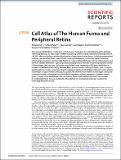Cell Atlas of The Human Fovea and Peripheral Retina
Author(s)
Yan, Wenjun; Peng, Yi-Rong; van Zyl, Tavé; Regev, Aviv; Shekhar, Karthik; Juric, Dejan; Sanes, Joshua R; ... Show more Show less
DownloadPublished version (8.168Mb)
Publisher with Creative Commons License
Publisher with Creative Commons License
Creative Commons Attribution
Terms of use
Metadata
Show full item recordAbstract
© 2020, The Author(s). Most irreversible blindness results from retinal disease. To advance our understanding of the etiology of blinding diseases, we used single-cell RNA-sequencing (scRNA-seq) to analyze the transcriptomes of ~85,000 cells from the fovea and peripheral retina of seven adult human donors. Utilizing computational methods, we identified 58 cell types within 6 classes: photoreceptor, horizontal, bipolar, amacrine, retinal ganglion and non-neuronal cells. Nearly all types are shared between the two retinal regions, but there are notable differences in gene expression and proportions between foveal and peripheral cohorts of shared types. We then used the human retinal atlas to map expression of 636 genes implicated as causes of or risk factors for blinding diseases. Many are expressed in striking cell class-, type-, or region-specific patterns. Finally, we compared gene expression signatures of cell types between human and the cynomolgus macaque monkey, Macaca fascicularis. We show that over 90% of human types correspond transcriptomically to those previously identified in macaque, and that expression of disease-related genes is largely conserved between the two species. These results validate the use of the macaque for modeling blinding disease, and provide a foundation for investigating molecular mechanisms underlying visual processing.
Date issued
2020Department
Howard Hughes Medical Institute; Koch Institute for Integrative Cancer Research at MIT; Massachusetts Institute of Technology. Department of BiologyJournal
Scientific Reports
Publisher
Springer Science and Business Media LLC